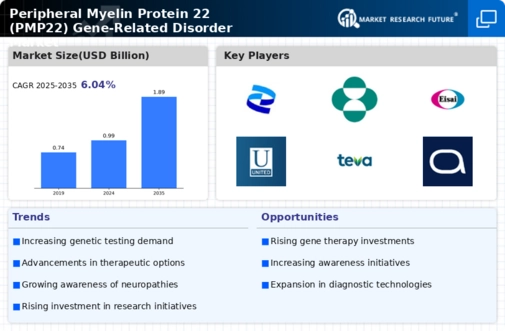Emerging Therapeutic Options
The emergence of novel therapeutic options for PMP22 gene-related disorders is a significant factor driving the Global Peripheral Myelin Protein 22 (PMP22) Gene-Related Disorder Market Industry. Recent developments in gene therapy and targeted treatments offer new hope for patients suffering from these conditions. For example, therapies aimed at correcting PMP22 mutations are currently in various stages of clinical trials, showing promising results. As these therapies become available, they are likely to transform the treatment landscape, attracting investment and increasing market value. The anticipated growth trajectory suggests a market expansion from 0.99 USD Billion in 2024 to 1.89 USD Billion by 2035.
Rising Awareness and Advocacy
The growing awareness and advocacy surrounding PMP22 gene-related disorders are pivotal in shaping the Global Peripheral Myelin Protein 22 (PMP22) Gene-Related Disorder Market Industry. Patient advocacy groups and healthcare organizations are actively promoting education about these conditions, leading to increased public knowledge and understanding. This heightened awareness is likely to encourage individuals to seek medical advice and genetic testing, thereby increasing diagnosis rates. As a result, the market is expected to experience substantial growth, with projections indicating a market value of 1.89 USD Billion by 2035, driven by a more informed patient population.
Advancements in Genetic Testing
Technological advancements in genetic testing are significantly influencing the Global Peripheral Myelin Protein 22 (PMP22) Gene-Related Disorder Market Industry. Enhanced testing methods allow for earlier and more accurate diagnosis of PMP22-related disorders. For example, next-generation sequencing has become a standard practice, enabling the identification of mutations with high precision. This trend is likely to increase the number of diagnosed patients, thereby expanding the market. As genetic testing becomes more accessible, it is anticipated that the market will grow at a compound annual growth rate (CAGR) of 6.04% from 2025 to 2035, reflecting the growing demand for genetic diagnostics.
Increasing Prevalence of PMP22 Disorders
The rising incidence of Peripheral Myelin Protein 22 (PMP22) gene-related disorders is a primary driver of the Global Peripheral Myelin Protein 22 (PMP22) Gene-Related Disorder Market Industry. As awareness and diagnostic capabilities improve, more cases are identified, contributing to market growth. For instance, the estimated prevalence of Charcot-Marie-Tooth disease, linked to PMP22 mutations, is approximately 1 in 2,500 individuals globally. This increasing recognition of PMP22-related conditions is expected to bolster the market, with projections indicating a market value of 0.99 USD Billion in 2024, potentially reaching 1.89 USD Billion by 2035.
Growing Investment in Research and Development
Investment in research and development (R&D) for treatments targeting PMP22 gene-related disorders is a crucial driver of the Global Peripheral Myelin Protein 22 (PMP22) Gene-Related Disorder Market Industry. Pharmaceutical companies are increasingly focusing on developing innovative therapies, including gene therapies and small molecules, aimed at addressing the underlying genetic causes. For instance, several clinical trials are currently underway, exploring novel treatment options that could significantly improve patient outcomes. This influx of R&D funding is expected to enhance the market landscape, with the market projected to grow from 0.99 USD Billion in 2024 to 1.89 USD Billion by 2035.

























Leave a Comment